Zencha9
They/Them- 4,234
- 1,731
No it's not, and i used it because the higher humans there are quite literally the same as the player, that being having no feats beside R.FIsn't umineko a special case anyway? Also it doesn't matter for the purpose of the CRT because most here doesn't know much about umineko so is kinda eh...
